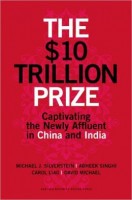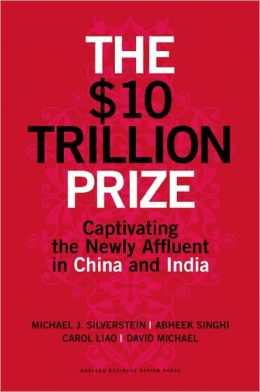 Authors: Carol Liao, David Michael, Michael J. Silverstein and Abheek Singhi
Authors: Carol Liao, David Michael, Michael J. Silverstein and Abheek Singhi
Publisher: Harvard Business Review Press – 314 pages
Book Review by: Sonu Chandiram
Economist John Williams gives us three statistics about the United States that will make you shake your head:
The first statistic is that for the last few years, the gross domestic product of the U.S. has been shrinking about 2 percent per year, instead of growing at about the same rate that major American media report to us. That is a 4 percent difference that amounts to a whopping $626 billion, or 4 percent of the current $15.66 trillion GDP of the U.S.
The second figure is the U.S. unemployment rate which is actually 23 percent, instead of the 7.7 percent that major national media have us believe.
And the third is the inflation rate of the U.S. economy. The actual rate of inflation is now running at 9.7 percent, nearly five times the 2 percent rate that the dominant U.S. media erroneously (or carelessly) report to the nation.
You see, the major national media – especially television networks and well-known newspapers – are quick to report what they receive in press releases from government agencies. In many instances, when you look at the numbers on the websites of the government agencies, you can get a complete, accurate and true picture, way better than what the major media report. The Internet truly empowers you.
What have these statistics got to do with China and India? Economic opportunities – money-making and wealth-creating chances that are open not just to large multinational (including U.S.) companies but to any individual who puts a little effort to avail of them, in active and passive ways.
For example, if you are earning just one percent interest per year on a $10,000 certificate of deposit, your gross gain is just $100 a year. But in fact, after factoring in the true 9.7 percent true inflation rate, you are losing $970 a year. Add your $100 interest gain for the year, and you are still losing $870 a year. Would you not want to minimize or eliminate the loss in value of your paper dollars by investing your $10,000 in a CD in an Indian bank that gives you 10 percent interest per annum? Of course you would.
Official GDP growth rates are much higher in China and India. Why is that the case? Mainly because hundreds of billions of dollars are flowing in from the United States, Europe and elsewhere into these two countries through two basic ways: multinational companies investing in China and India to establish some sort of presence, or export revenues coming into these two countries from the rest of the world, particularly developed nations.
The economic ‘presence’ of a multinational U.S. company could be a small 100-person sales and operations office for example, to large one, such as the 12 buildings in India that Microsoft owns, wherein some 5,800+ Indian employees work, or more than 14 percent of its 39,781 overseas employees. Additionally, a lot of Indian immigrants work in U.S.-based Microsoft offices.
As of December 31, 2012, Microsoft had 97,106 employees worldwide, of which 57,325 or 59 percent worked in the U.S. The nine Indian cities where it has operations are: Ahmedabad, Bangalore, Chennai, Hyderabad, Kochi, Kolkata, Mumbai, New Delhi and Pune. In some cities, more than one building is present.
The $10 Trillion Prize is a highly informative book but I must emphasize that it is not just for company owners or managers. It is meant for any individual that understands the effect of globalization whether it impacts you in a negative way – such as losing your job to someone in India – or whether you are deriving positive benefit from it – such importing Indian handicrafts in your small business and selling them in the U.S. at a huge profit.
For companies big or small that are considering to do business in China or India or both, the scope of these markets that the authors draw, is huge. Obviously, only middle class people can afford to buy American products. For the poor they would be too costly. So consider this: there are already hundreds of millions of middle class consumers in these two countries, and in less than ten years, that number will grow to nearly one billion.
As a matter of fact, in just eight years from now in 2020, more than two out of three or 68 percent of Chinese households and more than one out of every two or 57 percent of Indian households will be in the middle or upper classes.
If your company wants to purchase higher-level intellectual services of good value at lower prices, you can do so right now, but in ten years, there will be 135 million more college graduates from Chinese and Indian colleges, compared to 30 million in the U.S.
While there are opportunities, there also pitfalls. Reading this eye-opening book with its three sections and 11 chapters within them will give you a balanced view. This is a good book packed with data, examples, and insight. Whether you know next to nothing, just or little or are quite familiar with the business environments in China and/or India, you will certainly get new information as I did, to widen my horizons. Get this book.







